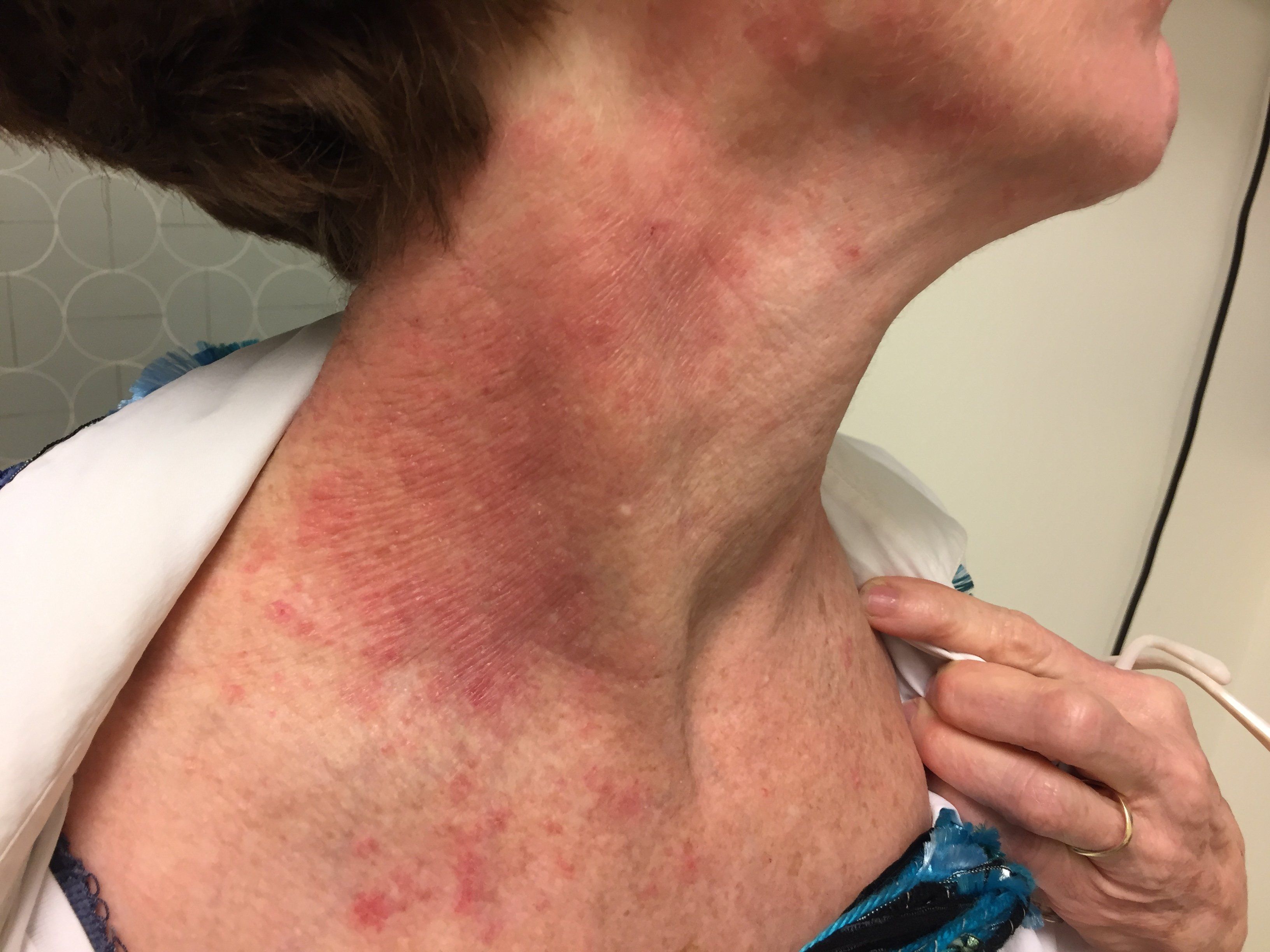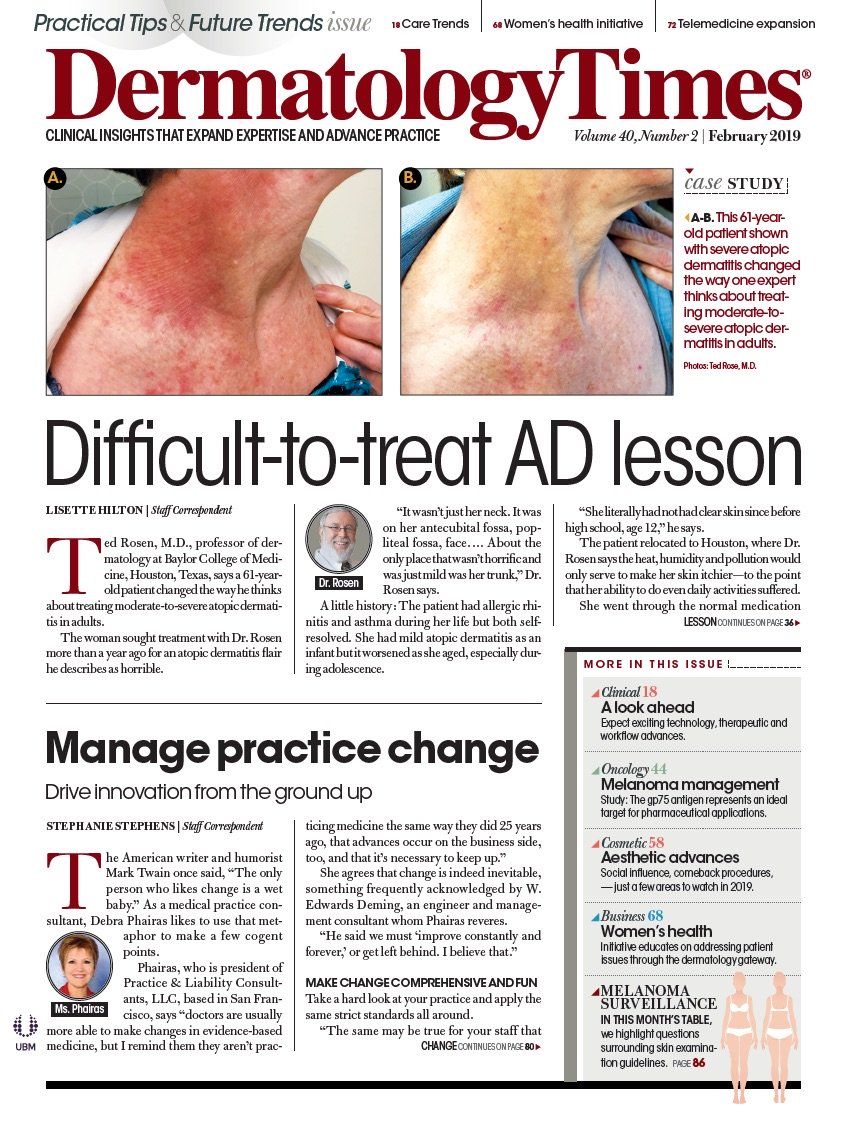
- Case-Based Roundtable
- General Dermatology
- Eczema
- Chronic Hand Eczema
- Chronic Spontaneous Urticaria
- Alopecia
- Aesthetics
- Vitiligo
- COVID-19
- Actinic Keratosis
- Precision Medicine and Biologics
- Rare Disease
- Wound Care
- Rosacea
- Psoriasis
- Psoriatic Arthritis
- Atopic Dermatitis
- Melasma
- NP and PA
- Skin Cancer
- Hidradenitis Suppurativa
- Drug Watch
- Pigmentary Disorders
- Acne
- Pediatric Dermatology
- Practice Management
- Prurigo Nodularis
- Buy-and-Bill
Publication
Article
Dermatology Times
Dermatologist shares lessons learned from difficult-to-treat atopic dermatitis case
Author(s):
Ted Rosen, M.D., professor of dermatology at Baylor College of Medicine, Houston, Texas, says a this 61-year-old patient changed the way he thinks about treating moderate-to-severe atopic dermatitis in adults. Share your difficult-to-treat cases with other health care providers on this forum. Participate in this forum.
Before: 61-year-old patient with severe atopic dermatitis. (Photo courtesy of Ted Rosen, M.D.)

The patient's skin after receiving only three dupilumab doses, or a month of treatment. (Photo courtesy of Ted Rosen, M.D.)

Ted Rosen, M.D., professor of dermatology at Baylor College of Medicine, Houston, Texas, says a this 61-year-old patient changed the way he thinks about treating moderate-to-severe atopic dermatitis in adults.
The woman sought treatment with Dr. Rosen more than a year ago for an atopic dermatitis flair he describes as horrible.
“It wasn’t just her neck. It was on her antecubital fossa, popliteal fossa, face…. About the only place that wasn’t horrific and was just mild was her trunk,” Dr. Rosen says.
A little history: The patient had allergic rhinitis and asthma during her life but both self-resolved. She had mild atopic dermatitis as an infant but it worsened as she aged, especially during adolescence.
“She literally had not had clear skin since before high school, age 12,” he says.
The patient relocated to Houston, where Dr. Rosen says the heat, humidity and pollution would only serve to make her skin itchier-to the point that her ability to do even daily activities suffered.
She went through the normal medication routine, according to Dr. Rosen. Topical steroids helped but didn’t clear her skin. And because the atopic dermatitis involved thin skinned areas of her face, neck and fossa, Dr. Rosen says long-term use of ultrapotent steroids like topical clobetasol or halobetasol was not an option. Mild or mid-potent steroids didn’t make much of an impact, and antihistamines didn’t help at all.
“So we embarked on the next level of therapy: methotrexate, which is sort of my fallback systemic drug. She didn’t tolerate methotrexate,” he says.
In fact, the patient had more than a five-fold increase in her baseline liver function test.
“It’s somewhere between three and five times that you start worrying about actually causing liver damage,” he says.
Next in line, Dr. Rosen tried cyclosporin, another go-to drug for moderate-to-severe adult atopic dermatitis. The patient had never been hypertensive but developed hypertension on cyclosporin, with significant systolic and diastolic elevations.
“We stopped the cyclosporin, re-challenged and she developed hypertension again. So, click that one off,” he says.
Dr. Rosen tried azathioprine (Imuran, Sebela Pharmaceuticals). She didn’t tolerate that drug, either. The patient experienced gastrointestinal side effects, including nausea, vomiting and diarrhea to the point of dehydration.
“Then, not because I think it’s the best drug but because I’m running out of options, I gave her mycophenolate mofetil (CellCept, Genentech) and that did nothing, even after allowing time for it to work,” he says.
She wasn’t a good candidate for phototherapy because of her fair skin and history with diagnoses of actinic keratosis, basal cell carcinoma and squamous cell carcinoma.
“While phototherapy might have been beneficial for her atopic dermatitis, it was really contraindicated because of her background of nonmelanoma skin cancer. You don’t want to do phototherapy on someone with a long history of skin cancer,” Dr. Rosen says.
The drug that finally worked after all the others failed was dupilumab, (Dupixent, Sanofi). The patient was able, with difficulty, to convince her insurance carrier to pay for the biologic--an IL 13 and IL 4 inhibitor that is FDA approved to treat atopic dermatitis.
The after photo is of the patient after receiving only three dupilumab doses, or a month of treatment, according to Dr. Rosen.
“It’s amazing,” Dr. Rosen says. “She said this is the best she had looked since age 11. She literally said you have given me my life back.”
A year into dupilumab treatment, the patient has only an occasional itch and remains for the most part clear. The only side effect has been eye irritation, which hasn’t reached the level of conjunctivitis or blepharitis, according to Dr. Rosen.
Dermatologists might face hurdles getting insurers to approve expensive biologics like dupilumab, he says, but it’s worth jumping those hurdles.
“Here’s the message (besides you’ve given me my life back): don’t wait. Go to the most efficacious agent that’s appropriate for patients as soon as it’s feasible,” Dr. Rosen says. “If there’s a patient objection to receiving a biologic drug, try and address it and skip ahead. I probably overdid trying different things. I think it’s reasonable to try an agent like methotrexate or cyclosporin and if that agent doesn’t work, plead your patient’s case to insurance carrier for a biologic.”
It’s an important lesson because dermatologists and other providers will have several such medicines from which to choose to treat atopic dermatitis in the coming years, according to Dr. Rosen.


Newsletter
Like what you’re reading? Subscribe to Dermatology Times for weekly updates on therapies, innovations, and real-world practice tips.
2 Commerce Drive
Cranbury, NJ 08512
All rights reserved.





